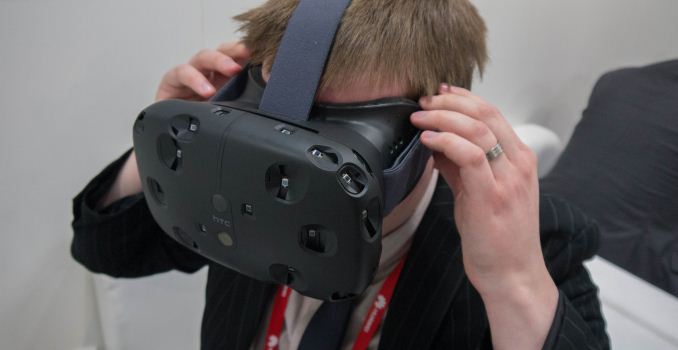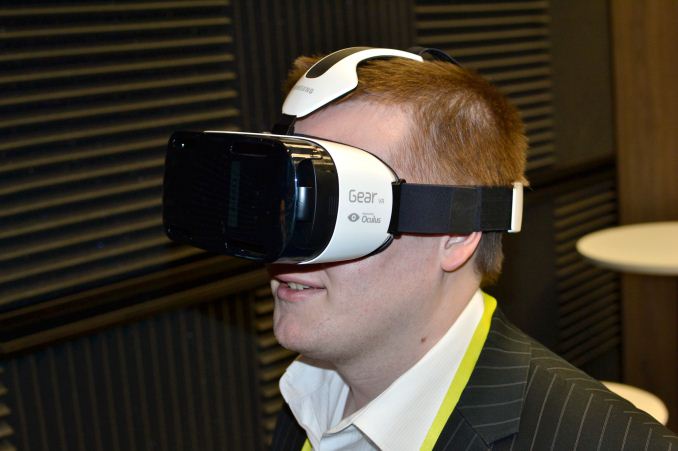IFA 2016: Examining the Malaise of Bargain Basement Virtual Reality
by Dr. Ian Cutress on September 9, 2016 9:00 AM EST
For the show this year, I left one day free just to roam freely around the show, looking for some insights or random bonus stories. One of the things that piqued my interest upon entering the International Tent was a number of VR headsets. It could be argued that the headsets that require a smartphone are a dime a dozen, so I scouted around for the VR headsets that were designed to come contained as all-in-one units and offer an untethered experience. A couple of the big names are touting untethered VR, so I asked around at a number of booths to look into the cheaper side of VR. For $100, you don’t get a lot.
For an all-in-one Virtual Reality headset, the core components include the screen resolution, screen size, screen quality, the SoC, the memory, the battery, the connectivity (wireless/LTE, USB etc.), the feel and the function of the headset are all key factors to get it right. In the myriad of six/seven headsets I was able to find in a morning at IDF, it was clear that almost all of these areas are gutted into the low-performance rung in order to meet very strict price points.
If we nostalgically look back to when Oculus was just starting, there were some clear defined goals that had to be achieved. For the most part they revolved around being to use the headset, eliminate nausea, and provide an immersive user experience. Millions of dollars and several prototypes later gave us the Rift, along with the Vive and other head-mounted displays (HMDs) that rely on a super powerful system behind it.
On the other side is Samsung Gear VR, leveraging an already owned premium smartphone with a reasonable element of a headset to house it – the smartphone is at a similar power budget to what you would expect to be the limit in front of the face. What these ‘bargain basement’ headsets try to do is try to provide all the hardware inside the headset, similar to the Gear VR, including SoC and battery and everything else, but for the same price as the Gear VR (minus smartphone). Of course, at the other end is Google Cardboard.
The true comparison points to these all-in-one VR systems could be the backpack VR units that house a laptop-like device, but these still require cables. The better comparison is to Intel’s Project Alloy, announced at IDF, or Qualcomm’s new VR820 platform, however both use internal and external cameras as part of a mixed VR/AR concept called mixed reality. We’ve seen other things like the SulonQ, which uses older AMD embedded parts, to provide the horsepower for an untethered VR experience as well. But all three of these are premium devices still in development. The goal of these cheaper headsets is to be super low cost, which also means there’s lots of competition to shave tenths of a cent off of the production costs.
As an additional caveat, the makers of these headsets I found on the show floor are the original design manufacturers, or ODMs. They are looking for bigger companies to order thousands of units and brand them under their own name, and subsequently deal with sales and distribution.












59 Comments
View All Comments
theduckofdeath - Wednesday, September 14, 2016 - link
I completely disagree on that. PC component reviews are a lot more relevant on Tom's. On here most reviews are basically marketing for equivalent Apple products, which means you get very little reviews or comparisons of components on here.sonicmerlin - Thursday, September 15, 2016 - link
Oh god just shut itfanofanand - Friday, September 9, 2016 - link
Yet another chicken/egg situation. There won't be any killer VR titles until VR is in the hands of millions, but until there are killer titles available the masses won't be buying VR headsets. For whatever reason $200 seems to be a psychological barrier. Once people can get one of these for under $200 as a self-contained unit I don't think we will see widespread adoption. Tethering yourself to a PC will never take off, nor will backpack units. Once we hit 7 nm maybe there will be sufficient economies of scale to make this work but I believe we are at least 5 years out, and in those 5 years I fear VR will follow 3D into the technology graveyard.theduckofdeath - Monday, September 12, 2016 - link
At E3 games like Resident Evil VII, Star Wars Battlefront and Fallout 4 were announced for VR. That is pretty top en AAA if you'd ask me.theduckofdeath - Monday, September 12, 2016 - link
*top endReflex - Friday, September 9, 2016 - link
Is there any chance of getting a look at the OSVR HDK2? Not all of us are intimidated by the configuration hurdles, I just want to know how the quality of the actual experience.Wolfpup - Friday, September 9, 2016 - link
I think the easiest way would be a Playstation 4 + Playstation VR, for something that's apparently real VR, even if it's not as good as the PC based things.Considering the three real VR headsets seem like they're just kind of "good enough" paired with a PS4 or a high end PC, these things running low to mid range phone CPUs are both hilarious, and kind of offensive.
Danvelopment - Friday, September 9, 2016 - link
Did you notice any booths selling tethered VR on the cheaps?PolarisTLX - Saturday, September 10, 2016 - link
Great article providing some handy perspective on this topic which making waves in the tech world. If you absolutely want to experience this today, then you should be ready to buy one if the high end headsets. Otherwise good but cheap headsets are still a couple years away at least.StrangerGuy - Saturday, September 10, 2016 - link
"Current estimates put 500k headsets in the market (of varying degrees of power) with another 2.7 million by the end of 2017"That's lolworthy economics of scale when AMD in it's darkest days can sell at least 10M discrete GPUs a year. Apple can probably sell that many iPhones within the first hour on iPhone launch day.